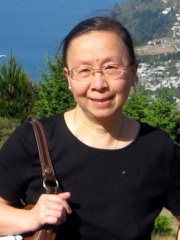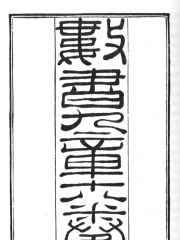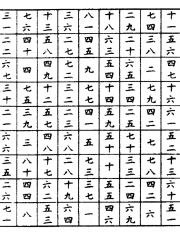
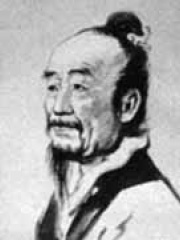
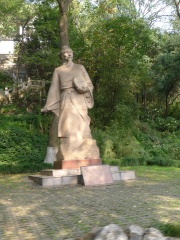

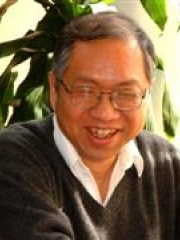
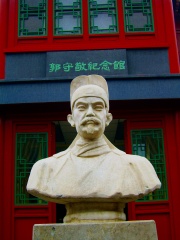
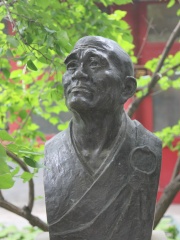

The Most Famous
MATHEMATICIANS from China
This page contains a list of the greatest Chinese Mathematicians. The pantheon dataset contains 1,004 Mathematicians, 20 of which were born in China. This makes China the birth place of the 11th most number of Mathematicians behind Hungary, and Switzerland.
Top 10
The following people are considered by Pantheon to be the top 10 most legendary Chinese Mathematicians of all time. This list of famous Chinese Mathematicians is sorted by HPI (Historical Popularity Index), a metric that aggregates information on a biography's online popularity. Visit the rankings page to view the entire list of Chinese Mathematicians.

1. Zhang Heng (78 - 139)
With an HPI of 73.62, Zhang Heng is the most famous Chinese Mathematician. His biography has been translated into 61 different languages on wikipedia.
Zhang Heng (Chinese: 張衡; AD 78–139), courtesy name Pingzi, formerly romanized Chang Heng, was a Chinese polymathic scientist and statesman who lived during the Eastern Han dynasty. Educated in the capital cities of Luoyang and Chang'an, he achieved success as an astronomer, mathematician, seismologist, hydraulic engineer, inventor, geographer, cartographer, ethnographer, artist, poet, philosopher, politician, and literary scholar. Zhang Heng began his career as a minor civil servant in Nanyang. Eventually, he became Chief Astronomer, Prefect of the Majors for Official Carriages, and then Palace Attendant at the imperial court. His uncompromising stance on historical and calendrical issues led to his becoming a controversial figure, preventing him from rising to the status of Grand Historian. His political rivalry with the palace eunuchs during the reign of Emperor Shun (r. 125–144) led to his decision to retire from the central court to serve as an administrator of Hejian Kingdom in present-day Hebei. Zhang returned home to Nanyang for a short time, before being recalled to serve in the capital once more in 138. He died there a year later, in 139. Zhang applied his extensive knowledge of mechanics and gears in several of his inventions. He invented the world's first water-powered armillary sphere to assist astronomical observation; improved the inflow water clock by adding another tank; and invented the world's first seismoscope, which discerned the cardinal direction of an earthquake 500 km (310 mi) away. He improved previous Chinese calculations for pi. In addition to documenting about 2,500 stars in his extensive star catalog, Zhang also posited theories about the Moon and its relationship to the Sun: specifically, he discussed the Moon's sphericity, its illumination by reflected sunlight on one side and the hidden nature of the other, and the nature of solar and lunar eclipses. His fu (rhapsody) and shi poetry were renowned in his time and studied and analyzed by later Chinese writers. Zhang received many posthumous honors for his scholarship and ingenuity; some modern scholars have compared his work in astronomy to that of the Greco-Roman scientist Ptolemy (AD 86–161).

2. Liu Hui (225 - 295)
With an HPI of 69.90, Liu Hui is the 2nd most famous Chinese Mathematician. His biography has been translated into 36 different languages.
Liu Hui (fl. 3rd century CE) was a Chinese mathematician who published a commentary in 263 CE on Jiu Zhang Suan Shu (The Nine Chapters on the Mathematical Art). He was a descendant of the Marquis of Zixiang of the Eastern Han dynasty and lived in the state of Cao Wei during the Three Kingdoms period (220–280 CE) of China. His major contributions as recorded in his commentary on The Nine Chapters on the Mathematical Art include a proof of the Pythagorean theorem, theorems in solid geometry, an improvement on Archimedes's approximation of π, and a systematic method of solving linear equations in several unknowns. In his other work, Haidao Suanjing (The Sea Island Mathematical Manual), he wrote about geometrical problems and their application to surveying. He probably visited Luoyang, where he measured the sun's shadow.

3. Zu Chongzhi (429 - 500)
With an HPI of 69.57, Zu Chongzhi is the 3rd most famous Chinese Mathematician. His biography has been translated into 35 different languages.
Zu Chongzhi (Chinese: 祖沖之; 429–500), courtesy name Wenyuan (Chinese: 文遠), was a Chinese astronomer, inventor, mathematician, politician, and writer during the Liu Song and Southern Qi dynasties. He was most notable for calculating pi as between 3.1415926 and 3.1415927, a record in precision which would not be surpassed for nearly 900 years.

4. Wang Chong (27 - 97)
With an HPI of 68.45, Wang Chong is the 4th most famous Chinese Mathematician. His biography has been translated into 37 different languages.
Wang Chong (Chinese: 王充; pinyin: Wáng Chōng; Wade–Giles: Wang Ch'ung; 27 – c. 97 AD), courtesy name Zhongren (仲任), was a Chinese astronomer, meteorologist, naturalist, philosopher, and writer active during the Eastern Han dynasty. He developed a rational, secular, naturalistic and mechanistic account of the world and of human beings and gave a materialistic explanation of the origin of the universe. His main work was the Lunheng (論衡, "Critical Essays"). This book contained many theories involving early sciences of astronomy and meteorology, and Wang Chong was even the first in Chinese history to mention the use of the square-pallet chain pump, which became common in irrigation and public works in China thereafter. Wang also accurately described the process of the water cycle. Unlike most of the Chinese philosophers of his period, Wang spent much of his life in non-self-inflicted poverty. He was said to have studied by standing at bookstalls, and had a superb memory, which allowed him to become very well-versed in the Chinese classics. He eventually reached the rank of District Secretary, a post he soon lost as a result of his combative and anti-authoritarian nature.
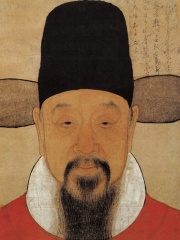
5. Xu Guangqi (1562 - 1633)
With an HPI of 66.30, Xu Guangqi is the 5th most famous Chinese Mathematician. His biography has been translated into 29 different languages.
Xu Guangqi or Hsü Kuang-ch'i (April 24, 1562 – November 8, 1633), also known by his baptismal name Paul or Paul Siu, was a Chinese agronomist, astronomer, mathematician, politician, and writer during the late Ming dynasty. Xu was appointed by the Chinese Emperor in 1629 to be the leader of the Shixian calendar reform, which he embarked on with the assistance of Jesuits. Xu was a colleague and collaborator of the Italian Jesuits Matteo Ricci and Sabatino de Ursis and assisted their translation of several classic Western texts into Chinese, including part of Euclid's Elements. He was also the author of the Nong Zheng Quan Shu, a treatise on agriculture. He is one of the "Three Pillars of Chinese Catholicism". The Roman Catholic Church considers him a Servant of God, one of the stages towards formal sainthood. On April 15, 2011, Vatican spokesman Federico Lombardi announced the start of a beatification process for Xu Guangqi, which has stalled.

6. Shing-Tung Yau (b. 1949)
With an HPI of 64.73, Shing-Tung Yau is the 6th most famous Chinese Mathematician. His biography has been translated into 39 different languages.
Shing-Tung Yau (; Chinese: 丘成桐; pinyin: Qiū Chéngtóng; born April 4, 1949) is a Chinese-American mathematician. He is the director of the Yau Mathematical Sciences Center at Tsinghua University and professor emeritus at Harvard University. Until 2022, Yau was the William Caspar Graustein Professor of Mathematics at Harvard, at which point he moved to Tsinghua. Yau was born in Shantou in 1949, moved to British Hong Kong at a young age, and then moved to the United States in 1969. He was awarded the Fields Medal in 1982, in recognition of his contributions to partial differential equations, the Calabi conjecture, the positive energy theorem, and the Monge–Ampère equation. Yau is considered one of the major contributors to the development of modern differential geometry and geometric analysis. The impact of Yau's work are also seen in the mathematical and physical fields of convex geometry, algebraic geometry, enumerative geometry, mirror symmetry, general relativity, and string theory, while his work has also touched upon applied mathematics, engineering, and numerical analysis.

7. Guo Shoujing (1231 - 1316)
With an HPI of 64.09, Guo Shoujing is the 7th most famous Chinese Mathematician. His biography has been translated into 27 different languages.
Guo Shoujing (Chinese: 郭守敬; 1231–1316), courtesy name Ruosi (若思), was a Chinese astronomer, hydraulic engineer, mathematician, and politician of the Mongol Empire and Yuan dynasty. The later Johann Adam Schall von Bell (1591–1666) was so impressed with the preserved astronomical instruments of Guo that he called him "the Tycho Brahe of China." Jamal ad-Din cooperated with him.

8. Yi Xing (683 - 727)
With an HPI of 63.66, Yi Xing is the 8th most famous Chinese Mathematician. His biography has been translated into 21 different languages.
Yixing (Chinese: 一行; pinyin: Yīxíng; Wade–Giles: I-Hsing, 683–727) was a Buddhist monk of the Tang dynasty, recognized for his accomplishments as an astronomer, a reformer of the calendar system, a specialist in the Yijing (易經), and a distinguished Buddhist figure with expertise in Esoteric Buddhism. In the realm of secular affairs, Yixing gained prominence for his reforms to the imperial calendar and his construction of a celestial globe featuring a liquid-driven escapement, the first in a long tradition of Chinese astronomical clockworks. Within Buddhist circles, he is particularly remembered for his contributions to the translation of the Mahāvairocana-sūtra and for authoring the authoritative commentary on that scripture, the Darijing shu 大日經疏 (T 1796). Due to his significant activities in both religious and secular spheres, a legendary portrayal of Yixing as a master astrologer and practitioner of astral magic developed during the late Tang period, leading to the attribution of several astrological works to him.

9. Liu Xin (50 BC - 23)
With an HPI of 63.40, Liu Xin is the 9th most famous Chinese Mathematician. His biography has been translated into 24 different languages.
Liu Xin (c. 46 BCE – 23 CE), courtesy name Zijun, was a Chinese astronomer, classicist, imperial librarian, mathematician, and politician during the Western Han and Xin dynasties. He later changed his name to Liu Xiu (劉秀) due to the naming taboo of Emperor Ai of Han. He was the son of Imperial librarian Liu Xiang and an associate of other eminent thinkers such as the philosopher Huan Tan. Liu was a prominent supporter of the Old Text classics.
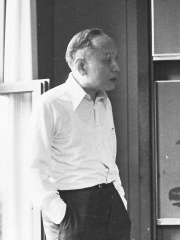
10. Shiing-Shen Chern (1911 - 2004)
With an HPI of 63.11, Shiing-Shen Chern is the 10th most famous Chinese Mathematician. His biography has been translated into 34 different languages.
Shiing-Shen Chern (; Chinese: 陳省身; pinyin: Chén Xǐngshēn; October 26, 1911 – December 3, 2004) was a Chinese American mathematician and poet. He made fundamental contributions to differential geometry and topology. He has been called the "father of modern differential geometry" and is widely regarded as a leader in geometry and one of the greatest mathematicians of the twentieth century, winning numerous awards and recognition including the Wolf Prize and the inaugural Shaw Prize. In memory of Shiing-Shen Chern, the International Mathematical Union established the Chern Medal in 2010 to recognize "an individual whose accomplishments warrant the highest level of recognition for outstanding achievements in the field of mathematics." Chern worked at the Institute for Advanced Study (1943–45), spent about a decade at the University of Chicago (1949-1960), and then moved to University of California, Berkeley, where he cofounded the Mathematical Sciences Research Institute in 1982 and was the institute's founding director. Renowned coauthors with Chern include Jim Simons, an American mathematician and billionaire hedge fund manager. Chern's work, most notably the Chern–Gauss–Bonnet theorem, Chern–Simons theory, and Chern classes, are still highly influential in current research in mathematics, including geometry, topology, and knot theory, as well as many branches of physics, including string theory, condensed matter physics, general relativity, and quantum field theory.
People
Pantheon has 20 people classified as Chinese mathematicians born between 50 BC and 1955. Of these 20, 3 (15.00%) of them are still alive today. The most famous living Chinese mathematicians include Shing-Tung Yau, Yitang Zhang, and Sun-Yung Alice Chang. The most famous deceased Chinese mathematicians include Zhang Heng, Liu Hui, and Zu Chongzhi.
Living Chinese Mathematicians
Go to all RankingsShing-Tung Yau
1949 - Present
HPI: 64.73
Yitang Zhang
1955 - Present
HPI: 52.96
Sun-Yung Alice Chang
1948 - Present
HPI: 49.87
Deceased Chinese Mathematicians
Go to all RankingsZhang Heng
78 - 139
HPI: 73.62
Liu Hui
225 - 295
HPI: 69.90
Zu Chongzhi
429 - 500
HPI: 69.57
Wang Chong
27 - 97
HPI: 68.45
Xu Guangqi
1562 - 1633
HPI: 66.30
Guo Shoujing
1231 - 1316
HPI: 64.09
Yi Xing
683 - 727
HPI: 63.66
Liu Xin
50 BC - 23
HPI: 63.40
Shiing-Shen Chern
1911 - 2004
HPI: 63.11
Zhu Shijie
1249 - 1314
HPI: 63.07
Qin Jiushao
1201 - 1261
HPI: 62.34
Yang Hui
1238 - 1298
HPI: 61.42
Overlapping Lives
Which Mathematicians were alive at the same time? This visualization shows the lifespans of the 6 most globally memorable Mathematicians since 1700.


